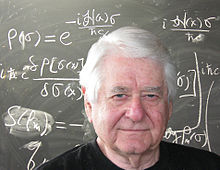John Moffat
| John Moffat | ||
|---|---|---|
 Moffat en 2007 | ||
| Información personal | ||
| Nacimiento |
24 de mayo de 1932 Copenhague, Dinamarca | |
| Residencia | Dinamarca, Reino Unido, Canadá | |
| Nacionalidad | Canadiense | |
| Educación | ||
| Educación | doctor en Filosofía | |
| Educado en | Trinity College, Cambridge | |
| Supervisores doctorales |
Fred Hoyle y Abdus Salam | |
| Supervisor doctoral | Fred Hoyle y Abdus Salam | |
| Información profesional | ||
| Ocupación | Físico, profesor universitario y científico | |
| Área | Físico, física, física de partículas, cosmología, gravedad, gravedad cuántica, astrofísica, astronomía y mecánica cuántica | |
| Conocido por |
Gravedad Teoría cuántica de campos Velocidad de la luz variable | |
| Empleador | Universidad de Toronto | |
| Sitio web | www.johnwmoffat.com | |
| Distinciones | Fundación John Templeton | |
John Moffat (1932) es profesor emérito de física en la Universidad de Toronto.[1] También es profesor adjunto de física en la Universidad de Waterloo y miembro del Instituto Perimeter de Física Teórica.
Investigación
[editar]Moffat es conocido por su trabajo sobre cosmología y gravedad, que se ha plasmado en su teoría gravitacional no simétrica y gravedad tensor-vector-escalar (ahora llamada MOG), y resumida en su libro Reinventando la Gravedad publicado en 2008. Su teoría explica las curvas de rotación de las galáxias sin contemplar los efectos de la materia oscura. Propone un enfoque de los problemas cósmicos con una velocidad variable de la luz, en el que G/c es constante en el tiempo, pero en el que G y c por separado no lo han sido. Además, la velocidad de la luz c puede haber sido mucho mayor durante los primeros momentos tras el Big Bang. Su trabajo reciente sobre los modelos cosmológicos homogéneos pretende explicar ciertos efectos anómalos en los datos del CMB, y dar cuenta de la recientemente descubierta aceleración de la expansión del universo.
Publicaciones
[editar]Libros
[editar]- Reinventing Gravity. HarperCollins. 2008. ISBN 0-06-117088-7.
Artículos seleccionados
[editar]- (1990) "Finite nonlocal gauge field theory," Phys. Rev. D 41: 1177-1184.
- (1993) "Superluminary Universe: A Possible Solution to the Initial Value Problem in Cosmology," Int. Jour. Mod. Phys. D2: 351-366.
- (1995) "Nonsymmetric Gravitational Theory," Phys. Lett. B 355: 447-452.
- (2006) "Scalar-Tensor-Vector Gravity Theory," JCAP 0603: 004.
Referencias
[editar]- ↑ Peter Calamai (27 de noviembre de 2005). «Einstein's respectful heretic». Toronto Star. Consultado el 13 de septiembre de 2012.
Enlaces externos
[editar]- Esta obra contiene una traducción 4 derivada de «John Moffat (physicist)» de Wikipedia en inglés, concretamente de esta versión, publicada por sus editores bajo la Licencia de documentación libre de GNU y la Licencia Creative Commons Atribución-CompartirIgual 4.0 Internacional.
Text is available under the CC BY-SA 4.0 license; additional terms may apply.
Images, videos and audio are available under their respective licenses.
